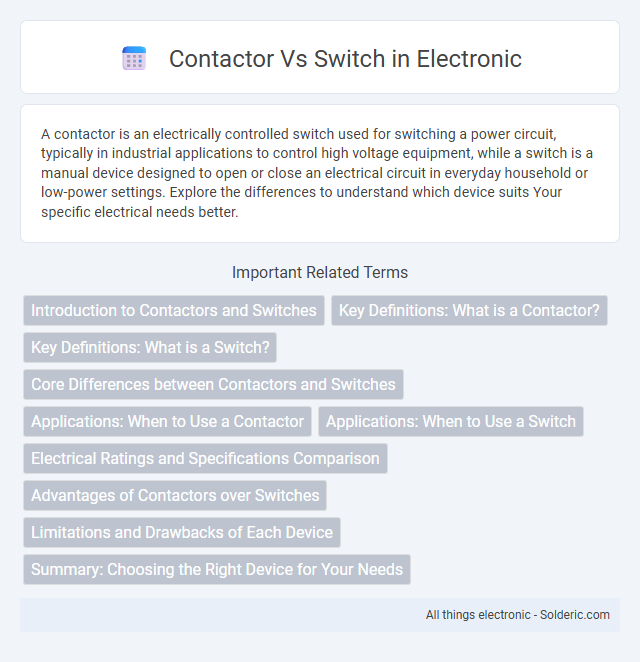A contactor is an electrically controlled switch used for switching a power circuit, typically in industrial applications to control high voltage equipment, while a switch is a manual device designed to open or close an electrical circuit in everyday household or low-power settings. Explore the differences to understand which device suits Your specific electrical needs better.
Comparison Table
| Feature | Contactor | Switch |
|---|---|---|
| Purpose | Electrically controls power circuits remotely | Manually opens or closes electrical circuits |
| Operation | Electromagnetic coil actuates contacts | Manual toggle or push mechanism |
| Load Capacity | High; designed for heavy electrical loads | Low to medium; suitable for basic circuits |
| Applications | Motor control, industrial automation, HVAC | Lighting, small appliances, household circuits |
| Remote Control | Yes, via control signals | No, manual operation only |
| Durability | High; built for frequent switching and heavy loads | Moderate; designed for general use |
Introduction to Contactors and Switches
Contactors and switches serve distinct roles in electrical circuits, with contactors designed to control high-power loads through remote switching, while switches provide manual operation for circuit control. Contactors offer enhanced electrical isolation and are equipped with electromagnetic coils to handle frequent on/off cycles in industrial settings. Understanding the differences between your contactor and switch ensures safer and more efficient control of electrical devices.
Key Definitions: What is a Contactor?
A contactor is an electrically controlled switch designed for switching an electrical power circuit, typically used in industrial applications to control large electrical loads such as motors, lighting, heating, and other electrical equipment. Unlike a standard switch, a contactor can handle high currents and is operated remotely through an electromagnetic coil, allowing for automatic or remote control. Your choice between a contactor and a switch depends on the load requirements and control needs of your electrical system.
Key Definitions: What is a Switch?
A switch is an electrical device designed to open or close an electrical circuit, allowing or interrupting the flow of current. It is typically used for manual operation to control lighting, appliances, or machinery by making or breaking a connection. Unlike contactors, switches are generally intended for lower current applications and do not have the capacity for remote or automatic control.
Core Differences between Contactors and Switches
Contactors are electrically controlled devices designed for switching high-power circuits in industrial applications, while switches are manually operated for low-power electrical control. Contactors feature an electromagnetic coil that enables remote control and automatic operation, offering higher durability and safety in heavy-duty conditions. Your choice depends on the need for automation and current capacity, with contactors suited for complex, high-load systems and switches ideal for simple, low-current tasks.
Applications: When to Use a Contactor
Contactors are ideal for applications requiring frequent switching of high-power electrical loads, such as motors, lighting systems, and industrial machinery. You should use a contactor when controlling large currents remotely or automatically in environments where durability and reliable performance under heavy-duty operations are critical. Unlike standard switches, contactors provide enhanced safety and prolonged operational life in commercial and industrial control circuits.
Applications: When to Use a Switch
Switches are ideal for low-voltage, manual control applications such as lighting, small appliances, and simple electrical circuits. They provide direct on/off operation without the need for complex control or remote management. Switches are best suited for environments where frequent, straightforward switching is required without the high current or automation capabilities typical of contactors.
Electrical Ratings and Specifications Comparison
Contactors typically handle higher electrical ratings, ranging from 9 to 600 amps and voltages up to 600 volts AC, designed for frequent switching in industrial applications. Switches generally support lower current capacities, often under 20 amps and voltages suitable for residential or light commercial use, with simpler ratings focused on on/off control. The difference in electrical specifications defines contactors for heavy-duty, high-load circuits, while switches suit lower-power, manual operations.
Advantages of Contactors over Switches
Contactors offer superior electrical load handling and remote control capabilities compared to switches, making them ideal for industrial automation and heavy machinery applications. They provide enhanced safety features, such as arc suppression and overload protection, reducing the risk of electrical faults and equipment damage. Their robust design supports frequent switching operations and integration with control systems, ensuring reliable performance under demanding conditions.
Limitations and Drawbacks of Each Device
Contactors, while ideal for controlling high-current circuits, face limitations such as mechanical wear due to frequent switching and susceptibility to contact pitting, which reduces lifespan and reliability. Switches, though simpler and cost-effective for manual control, lack the capacity for high current loads and offer limited automation integration, making them unsuitable for complex or heavy-duty electrical systems. Both devices require careful selection based on current ratings, load types, and application environments to avoid performance issues and ensure safety.
Summary: Choosing the Right Device for Your Needs
Selecting between a contactor and a switch hinges on the specific electrical application and load requirements. Contactors excel in handling high current loads and enabling remote or automated control in industrial environments, while switches are suited for manual operation of lower current circuits. Understanding voltage ratings, operational frequency, and control mechanisms ensures optimal device performance and safety.
Contactor vs Switch Infographic

 solderic.com
solderic.com